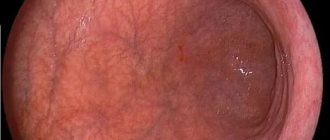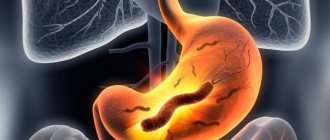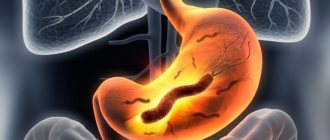More about pathology
Lymphoid gastritis, in fact, is a consequence of chronic gastritis caused by the bacteria Helicobacter pylori (Helicobacter pylori infection) entering the body through household means (through shared dishes, kisses, hygiene items). The proliferation of this microorganism in the stomach environment inevitably leads to irritation of its mucous membrane.
To fight Helicobacter pylori bacteria, the immune system sends a large proportion of lymphocytes (the body's defender cells) to the lesion. The latter begin to accumulate on the inflammation, forming follicles. This is why the second name for this form of gastritis is follicular. Formations in the form of rounded bubbles resist bacteria, but at the same time prevent the cells of the stomach from fully producing gastric juice necessary for digestion.
Subsequently, the lymphoid follicles in the stomach grow so much that they turn into a rather dense thallus, which greatly impedes the activity of the epithelial cells of the organ. The result is a decrease in the production of hydrochloric acid, which is so necessary for the digestive process.
Lymphoid gastritis is also called follicular. This is a special type of pathology that affects the inner epithelial layer of the stomach. This form does not occur very often; it is diagnosed in 1% of cases of all types of gastritis.
Why is lymphoid gastritis dangerous? Normally, lymphocytes should “scan” the properties and quality of incoming food. If pathogens are found in food, lymphocytes “transmit information” to the cells of the immune system. These, in turn, provide protection to the body by destroying pathogenic microflora.
With the development of pathology, lymphocytes are mistakenly mistaken for dangerous “strangers” of epithelial tissue cells. As a result, the immune system attacks them, causing inflammation of the mucous membrane. In this case, follicles - growths - form on the surface.
Such growths can grow to large sizes, interfering with the functioning of the digestive system. If left untreated, the disease progresses and can lead to the development of cancer or ulcers.
The reason for the malfunction of lymphocytes has not yet been established. However, there are known factors that can contribute to the development of the disease. This:
- infection with Helicobacter pylori infection;
- hereditary predisposition;
- dry food, non-compliance with diet;
- bad habits – smoking, alcohol abuse;
- constant stress.
The listed factors can be present individually or in combination, all of them have a detrimental effect on the digestive organs.
The causes of this type of gastritis have not been fully elucidated by medical scientists to this day. But the most plausible assumptions are:
The onset of the disease begins with the development of celiac disease (celiac disease). It is characterized by intolerance to gluten, a protein found in most grains, especially rye, barley, wheat and oats. For the body of people with celiac disease, gluten is foreign, so immune cells begin to block it already in the stomach. But at the same time with this protein, they also injure healthy cells of the surface layer of the mucosa.
The development of this form of gastritis is caused by infection of the gastric mucosa and duodenum with pathogenic microorganisms Helicobacter pylori. Proof of this theory are specific changes in the tissues of the mucous membrane, typical of the bacterial form of the disease.
Lymphoid gastritis occurs against a background of chronic gastritis. Also, when examining patients, it turns out that each patient has an active growth of Helicobacter, causing inflammation of the mucous membrane. After entering the stomach, the pathogenic microorganism begins to secrete a special substance - urease, which strongly irritates the mucous membrane.
The exact reason for the development of this particular pathology is unknown; it is clear that lymphoid gastritis occurs against a background of chronic gastritis.
The body responds with a protective reaction - it enhances the synthesis of pepsin and hydrochloric acid. A rare form of gastritis has distinctive features in the form of accumulations of lymphocytes that unite into follicles in the area of irritation and degeneration of the epithelium.
Lymphatic vesicles formed in large quantities, necessary for the restoration of areas affected by Helicobacter, are often confused with hypertrophied gastritis or tissue atrophy - this is the difficulty of diagnosis. The uneven distribution of formations and thickening of the folds of the mucosa impede the normal functioning of healthy cells and the production of enzymes.
Another name for the disease - follicular gastritis - was given to it due to the appearance of formations - follicles, which can grow to significant sizes, form a dense layer, thereby complicating not only the digestion process, but also the diagnosis of the pathology itself. The development of a rare form of the disease is facilitated by inflammation of the mucous membrane, which was ignored for a long period of time, and there was no necessary treatment and prevention.
A rare form of the disease usually does not cause much suffering to the patient. The initial stage of the disease is often confused with superficial gastritis, which develops with increased acidity and an increase in the number of Helicobacter. Diagnosis of gastritis is often difficult due to the lack of specific manifestations of lymphoid pathology, and at the initial stage – very disturbing symptoms. Follicular gastritis is easily confused with the hypertrophic or atrophic form.
Characteristics of lymphocytic gastritis
The pathology is an inflammatory process that affects the gastric mucosa. The main sign of a nonspecific form of the disease is considered to be pronounced lymphocytic infiltration of the epithelium (penetration of foreign particles) together with the appearance of plasma cells in the lining of the stomach.
According to doctors, the most likely causes of the appearance of characteristic signs of lymphocytic gastritis can be two main factors:
- Intolerance to gluten (celiac disease) and certain medications. Gluten is a protein found in grains, but for people with celiac disease, the protein becomes foreign. This causes gluten in the stomach to be blocked by immune killer cells, which leads to injury to the healthy cellular structures of the inner lining.
- It has been established that the gastrointestinal tract is infected with a pathogenic microorganism called Helicobacter pylori. The presence of bacteria in the surface layers of the gastric mucosa results in the fixation of characteristic changes in the structure of the epithelium, typical for the form of the disease associated with the bacterium.
Who is at risk?
The lymphocytic form of gastritis affects women 3 times more often than men. Mostly, the pathology is detected in people aged 60–80 years. In rare cases, it occurs in infants. The risk of developing the disease increases if a person drinks alcoholic beverages, smokes, or abuses fatty and fried foods.
The patient can independently provoke inflammation if he takes any medications without a doctor’s prescription, which disrupts the body’s protective functions and contributes to damage to the mucous membrane.
Diet and lymphoid follicles in the stomach
Treatment of the lymphoid form of gastritis will be unproductive if the patient does not follow the diet necessary for his illness. In this table you can see the list of prohibited and required products.
| Required: | Prohibited: |
|
|
To restore the functions of the stomach, you need to eat fractionally - 5-6 times a day, in small portions. Make sure the food is warm, not hot or cold. Chew food slowly and thoroughly. In addition to this, it is recommended to completely stop smoking.
Causes of focal gastric hyperplasia
Doctors call hyperplasia an endoscopic disease. In most cases, there are no symptoms of pathology; thickening of the epithelium as a result of a high rate of cell division is detected when examining the stomach with an endoscope. The exact type of disease can only be determined after a tissue biopsy.
- hormonal disbalance;
- chronic gastritis;
- peptic ulcer;
- hereditary tendency to focal hyperplasia;
- an abnormal deviation in the regulation of the functioning of an organ by the nervous system;
- advanced form of chronic inflammation of the mucous membranes of the organ;
- incompletely cured infectious diseases in the stomach;
- Helicobacter;
- defects in the intrasecretory functioning of the stomach;
- negative impact of a carcinogen or other chemical compounds on mucous membranes.
- Hormonal disorders occurring in the body;
- Hereditary predisposition;
- Presence of Helicobacter bacteria in the body;
- The effect of any carcinogens;
- Stomach infections that have not been fully treated;
- Advanced chronic inflammatory processes occurring in the tissues of the stomach.
All these reasons lead to the complication of chronic gastritis by hyperplasia, pathological proliferation of cells of its mucous membrane, which, in turn, contributes to the formation of malignant tumors in the body of the stomach.
What happens with lymphocytic gastritis
A rare form of chronic gastric disease is characterized by a non-standard development pattern. Inflammation in the lymphoid type of pathology is not the result of a destructive process in the lining of the stomach due to irritation, but a response to the opposition of lymphocytes.
Local immunity in the stomach is responsible for lymphoid tissue, consisting of special cells, among which there are lymphocytes of varying degrees of maturity, as well as clusters of follicles.
After the penetration of leukocytes (infiltration) and a further increase in their number in the cells of the gastric epithelium, autoimmune reactions develop, which gives the right to speak of lymphoid gastritis as a separate stage of lymphocytic.
By protecting a segment of the damaged area of the stomach, lymphocytes attack inflammation, saving the body. Under the influence of provoking factors, lymphocytic follicles grow, this leads to uneven thickening of the gastric folds.
Symptoms of lymphoid gastritis
With the lymphoid form of the disease, patient complaints are very similar to the clinical picture that is present with Helicobacter pylori gastritis. They are usually expressed as follows:
- Painful sensations that appear not only on an empty stomach (morning pain), but also some time after eating;
- Sour belching and frequent heartburn, but loss of appetite, which occurs with other inflammatory forms of gastrointestinal diseases, is not observed;
- Stool disorders, which are expressed in frequent constipation. As lymphoid gastritis progresses, symptoms such as heaviness in the stomach, accompanied by bloating, nausea, which progresses to vomiting, begin to appear. Also, stool instability as the disease progresses changes from frequent constipation to diarrhea. If the disease is not treated, then its external symptoms appear, namely: The tongue is covered with a white coating;
- Cracks and jams in the corners of the mouth;
- The patient is excessively thin, despite a normal appetite.
Progressive lymphoid inflammation manifests itself as:
- heaviness in the stomach, accompanied by bloating;
- nausea, turning into vomiting;
- frequent changes from diarrhea to constipation and vice versa.
The advanced, untreated form of the disease is characterized by the appearance of the following external signs:
- coating of the tongue with a dense white coating;
- formation of cracks and sticking in the corners of the lips;
- excessive thinness.
Endoscopic signs:
- the formation of granular bulges on the gastric mucosa, similar to small warts;
- proliferation of lymphoid tissue in the form of roughness;
- visualization of pale pink epithelium with thickened folds with small punctate erosions.
Prevention of follicular gastritis
To avoid suffering from the disease again, you need to do the following:
- Do not give up the diet at the first improvements. Ideally, it should be followed for at least a year.
- Drastically switch to a healthy diet, forever give up junk food, smoking and alcohol.
- Schedule a visit to your gastroenterologist every six months.
Lymphoid follicles in the stomach are a rare but completely curable form of gastritis. As with other types, the patient must undergo a course of drug treatment, follow a special diet, and when curing, do not forget about prevention.
Chronic lymphoid gastritis with lymphofollicular hyperplasia
With this type of disease, there is always a strong growth of the follicular layer in the gastric mucosa with a pathological increase in the number of its cells. This process usually develops due to hormonal disorders or as a result of exposure to various negative influences on internal tissues.
Lymphofollicular hyperplasia in the lymphoid form of the disease always occurs when the patient has chronic mixed gastritis, which resulted from infection with the bacterium Helicobacter pylori. Experts believe that this formation of follicles is a response to the proliferation of these bacteria in the mucous membrane. At the same time, the sweet lymphoid tissue located in the gastric mucosa becomes very thick due to the formation of lymphocytic follicles.
Often they can reach simply enormous sizes, which is why they can easily be mistaken for false atrophy of the digestive organ. For the most accurate diagnosis, in order to exclude any errors, in case of lymphoid gastritis with lymphofollicular hyperplasia, in addition to a biopsy, fluoroscopic examination should always be used.
This helps to determine the degree of safety of the growths occurring in the mucous tissues of the stomach and the possible risk of their degeneration into a malignant neoplasm. Only with a complete and thorough diagnosis is it possible to prescribe the correct treatment for lymphocytic gastritis, as well as protect the body from possible relapses of this dangerous and little-studied form of the disease.
Preventing Disease
It is recommended to follow preventive measures to prevent the development of pathology. Gastritis of the lymphoid type may have a bacterial root cause. If one family member has an illness, he is isolated. Everyone living with him undergoes preventive treatment.
A healthy person or someone who has once experienced gastritis should always monitor their diet. It is recommended to give preference to a gentle diet. Excluded from the diet:
You need to give up bad habits. It is recommended to consume only fresh and high-quality food. If unpleasant symptoms appear, visit a medical facility.
You can learn about the symptoms of gastritis from the video:
Among the variety of types and forms of gastritis, there is a rare type of chronic form of the disease called lymphocytic gastritis. This little-studied pathology is usually diagnosed in older people, most often women; children rarely suffer from the disease.
A serious problem is detected during laboratory examination of the gastric mucosa. The disease itself is not so scary, but the complications it provokes result in severe stomach discomfort and can result in death.
Establishment of pathology
It is impossible to independently establish a diagnosis based on the presenting symptoms. Even the most experienced doctor cannot do this. There is a need to undergo a number of tests. The diagnosis is made based on their results. The disease does not have characteristic features that would make it possible to accurately determine the disease without special studies.
Diagnostics includes:
- taking anamnesis;
- studying the signs present;
- endoscopy of the gastric mucosa using a special device;
- biopsy - during this procedure, tissue is collected from the affected area for further examination;
- general and biochemical blood test;
- urine test;
- echocardiogram of internal organs.
Diagnostics
It is difficult to identify lymphoid gastritis. The difficulty is due to the similarity of symptoms with other types of gastritis.
Endoscopic examination
Several methods are used for diagnosis:
- Laboratory research. The patient undergoes clinical tests of urine and feces, fecal occult blood tests, general blood tests, biochemical blood tests, and detection of Helicobacter.
- Endoscopy. The method is known: a flexible probe with a camera at the end is inserted into the stomach through the esophagus. On the monitor, the doctor has the opportunity to see the condition of the mucous membrane, the presence and nature of changes.
- Biopsy. It is done together with endoscopy. A piece of stomach tissue is taken through a probe for analysis.
- Ultrasonography. It is carried out in individual cases and helps to identify the extent of the proliferation of lymphoid tissue.
The use of the endoscopic method makes it possible to determine that the patient has lymphoid rather than antral gastritis, caused by a similar Helicobacter pylori infection. The variant is localized in the antrum of the stomach and has acute erosive changes in the mucosa.
Treatment of lymphoid gastritis
The duration and effectiveness of treatment for gastritis depends on how long the sick person decided to seek help from a doctor, on a full examination, and on following all prescribed therapeutic recommendations.
Follicular gastritis, which appears against a background of chronic gastritis, requires the use of various medications that relieve inflammation of the gastric mucosa, eliminate pain, have an enveloping effect, the ability to reduce and regulate the production of hydrochloric acid, and help break down food with the help of enzymes. If Helicobacter is detected in the gastric environment, a course of antibiotics is prescribed to suppress pathogenic microorganisms.
A course of treatment for follicular gastritis should be prescribed by a qualified specialist. Ignoring the symptoms of a developing dangerous disease, waiting for everything to “resolve” on its own, and self-medicating is unacceptable.
Taking the recommended medications strictly according to the prescribed regimen allows you to effectively fight gastritis and quickly improve your well-being.
In addition to the use of medications, it is important to exclude all factors that provoked the development of gastritis:
- establish a meal schedule, optimize the composition of food products, eliminate heavy meals, stick to a diet;
- not just minimize bad habits, but get rid of them, no matter how difficult it may be;
- maintain a sleep and rest schedule;
- try to provide a comfortable emotional environment at home and at work that is favorable for healing;
- spend more time outdoors.
How is the primary diagnosis of pathology carried out?
When the first signs of discomfort and suspicion of gastritis appear, you should contact a specialist. A gastroenterologist deals with problems of the gastrointestinal tract.
The doctor will prescribe a series of studies and tests confirming gastritis in general or its lymphocytic variety:
- Prescribing a general blood test helps to identify the threat of the inflammatory process;
- Thanks to a detailed blood test, the fact of metabolic process failures is detected;
- By analyzing stool, the hidden presence of blood in it is checked;
- Histological results indicate the degree of damage to cellular structures;
- By examining gastric juice, the acidity of the medium is determined.
Important! The main method for diagnosing signs of lymphocytic gastritis is fibrogastroduodenoscopy. The results of the study are the most informative; this is the main diagnostic method that allows us to establish the presence or absence of non-standard pathology.
Folk remedies
Additionally, you can use various folk remedies to treat gastritis of all types, including lymphoid. Ingredients such as honey, vegetable juices, and medicinal plants are inexpensive and accessible products that are found in every home. They have antibacterial and anti-inflammatory effects and heal the mucous membrane well.
For gastritis of the lymphoid type, it is recommended to take honey and propolis. These products neutralize the acidic environment in the stomach and promote epithelial regeneration.
Honey can be eaten in its pure form, one or two tablespoons per day, before meals. Honey water also works well. Dissolve 15–20 grams of honey in a glass of warm water. Drink half an hour before meals three times a day.
Propolis tincture is diluted in water in a ratio of 10 drops per 100 ml. It can be purchased at a pharmacy. You need to drink half a glass before meals 20–30 minutes. Take honey water or propolis for two weeks.
Sea buckthorn oil is used as an anti-inflammatory and analgesic. You should drink one teaspoon half an hour before meals. Juice from black currant berries can be taken with low acidity. Drink half a glass of juice three times a day.
Potato juice has high bactericidal properties. It neutralizes hydrochloric acid contained in the stomach. You can only drink freshly squeezed juice from young fruits. Consume the drink immediately after production. You can use juice squeezed from white cabbage in the same way. The compositions are drunk three times a day, a third of a glass.
Herbs and herbs
Herbal preparations and monocomponent herbal remedies have a positive effect on the treatment of follicular gastritis, such as:
- Tea made from lemon balm leaves and flowers has antibacterial properties, relieves spasms and is an immunomodulator that can suppress the activity of lymphoid cells. Drinking is allowed in any quantity.
- Herbal mixture: licorice and calamus roots, mint, flaxseeds, linden flowers. The components are taken in equal proportions, half a tablespoon of the entire mixture is poured into 25 ml of boiling water. After an hour, the drink is filtered and drunk. Fresh tea should be prepared for consumption three times a day. Drink warm for 2 weeks.
- Decoction of licorice roots. Take 1 large spoon of powder and dilute it in 250 ml of boiling water. The product is boiled for 20 minutes. in a water bath. After a quarter of an hour, the drink is filtered and taken 15 ml four times a day for a period of 3 weeks.
- Collection: 40 g chamomile flowers, 20 g flaxseeds, 40 g yarrow. 30 g of raw material is poured into a glass of boiling water. After 30 min. drink 70 ml before three main meals. You need to be treated for 3 weeks.
- Infusion of calamus root. Powder in the amount of 1 small spoon is poured into 250 ml of boiling water and left for 40 minutes. Drink within 30 minutes. before breakfast, lunch and dinner. Duration of treatment – 2 weeks.
- Collection: celandine, chamomile flower, yarrow, St. John's wort. 1 small spoon of raw material is poured into a glass of boiling water. Drink 25 ml after 20 minutes. after settling.
- A decoction of flax seeds. Prepared from 2 small spoons of powder, filled with cold water. The drink is brewed for 10 minutes over low heat and left for an hour. Drink 15 ml in 15 minutes. before the start of the meal, a course of 4 weeks.
- Burdock roots. Powder in the amount of 30 g is poured into 1 liter of boiling water and infused for a day. Drink half a glass up to 5 times a day before each snack for 3 weeks.
The course of gastritis general description
Gastritis is a group of acute and chronic diseases characterized by inflammatory or inflammatory-dystrophic changes in the gastric mucosa. There are acute gastritis (characterized by neutrophilic infiltration) and chronic (neutrophilic leukocytes, plasma cells and lymphocytes are detected in the infiltrate).
Course of acute gastritis
Symptoms of acute gastritis usually appear 4-8 hours after exposure to the etiological factor. Nausea, drooling, an unpleasant taste in the mouth, belching appear, then cramping pain in the epigastric region occurs, vomiting does not bring relief, sometimes with an admixture of bile. The skin and visible mucous membranes are pale, the tongue is covered with a grayish-white coating, drooling or, conversely, severe dry mouth.
Gastritis is a group of acute and chronic diseases characterized by inflammatory or inflammatory-dystrophic changes in the gastric mucosa
Palpation reveals pain in the epigastric region. During endoscopic examination, the mucous membrane is thickened, hyperemic, edematous, hemorrhages and erosions are detected, and microscopically the infiltration of the superficial, sometimes dystrophic, necrobiotically altered epithelium with leukocytes is determined. The duration of the disease is 2-6 days.
Course of corrosive gastritis
Corrosive gastritis develops due to the ingestion of strong acids, alkalis, and salts of heavy metals into the stomach. Immediately after taking a toxic substance, severe burning pain appears, often unbearable in the mouth, behind the sternum and in the epigastric region. Repeated painful vomiting does not bring relief; in the vomit there is blood, mucus, and sometimes tissue fragments.
On the lips, mucous membrane of the mouth, pharynx and larynx there are traces of a chemical burn: swelling, hyperemia, ulcerations (grayish-white spots appear from sulfuric and hydrochloric acid, yellow and greenish-yellow scabs from nitric acid, brownish-red scabs from chromic acid, carbolic acid - bright white, reminiscent of lime deposits; acetic acid - superficial whitish-gray burns).
Course of acute catarrhal gastritis
Catarrhal gastritis is an acute or chronic inflammation of the gastric mucosa caused by exposure to negative factors: infections, consumption of excessively hot, cold, spicy, etc. food, non-compliance with food regimen and hygiene.
Acute catarrhal gastritis is characterized by the following course of the disease:
- stabbing or cutting pain in the upper abdomen and umbilical region;
- heartburn and/or belching with a bitter aftertaste;
- sour breath;
- nausea, which may result in episodes of vomiting (traces of bile are present in the vomit);
- white-gray coating on the tongue;
- acute catarrhal gastritis may be accompanied by an increase in body temperature.
In the absence of attention to these symptoms, the disease becomes chronic. In this case, stool disorders (mainly constipation), bloating and flatulence may be added to the already listed symptoms. Sustained disturbances of the digestive processes during gastritis inevitably lead to disturbances in other systems and organs. Thus, there is often a feeling of constant fatigue, irritability, and drowsiness.
The course of phlegmonous gastritis (stomach phlegmon)
Phlegmonous gastritis (stomach phlegmon) is extremely rare and is characterized by phlegmonous inflammation of the stomach wall with diffuse or limited distribution of pus mainly in the submucosal layer; usually recognized during surgery.
Characterized by acute development with chills, increased body temperature, severe adynamia, pain in the upper abdomen, nausea and repeated vomiting, sometimes with blood and pus. The tongue is dry, the stomach is swollen. The general condition is deteriorating sharply. Patients refuse to eat and... drinking, quickly become exhausted, facial features change (the so-called Hippocratic face). In the epigastric region there is pain on palpation.
Reasons for development
It is impossible to determine the exact causes of the disease. Today, most gastroenterologists believe that the disease develops against the background of individual intolerance to gluten, which is part of most bread and other baked goods, and cereal products.
In people suffering from lymphofollicular gastritis, the body's defenses attack this protein (gluten), considering it a health threat. Having dealt with gluten, immune cells are mistaken for the tissues of the digestive tract.
Doctors are convinced that Helicobacter pylori, which causes various pathological processes in the gastrointestinal tract, also makes its destructive contribution. Her favorite organs are the stomach and duodenum. With lymphocytic gastritis, lesions characteristic of this pathogenic bacterium are found in the tissues of these organs, and its presence is confirmed by the results of laboratory tests.
Doctors believe that people who abuse sweet soda, alcoholic beverages, and “junk” foods (chips, crackers, sandwiches) are at risk and can develop this type of gastritis. The list of potential victims also includes fans of fatty, spicy, fried and smoked foods.
In addition to lymphocytic, there is also plasmacytic gastritis, and also of unclear etiology. This form is characterized by the accumulation of a large number of leukocytes in the organs of the digestive tract. The symptoms of the disease are similar to typical manifestations of chronic inflammation of the inner lining of the stomach. Without a thorough medical examination and laboratory test results, pathology cannot be diagnosed.











